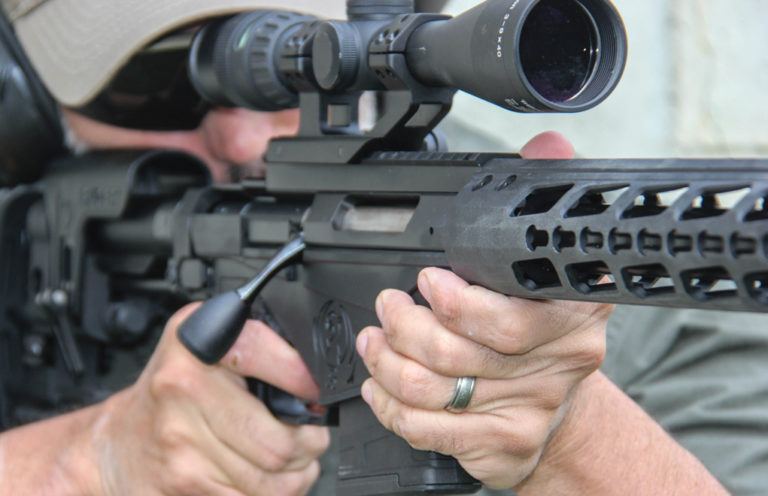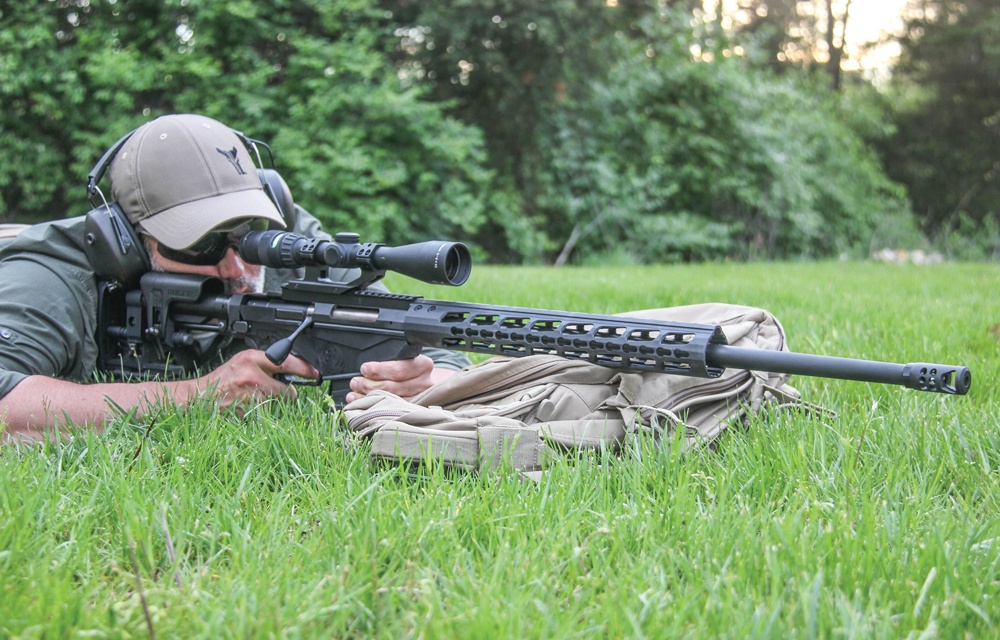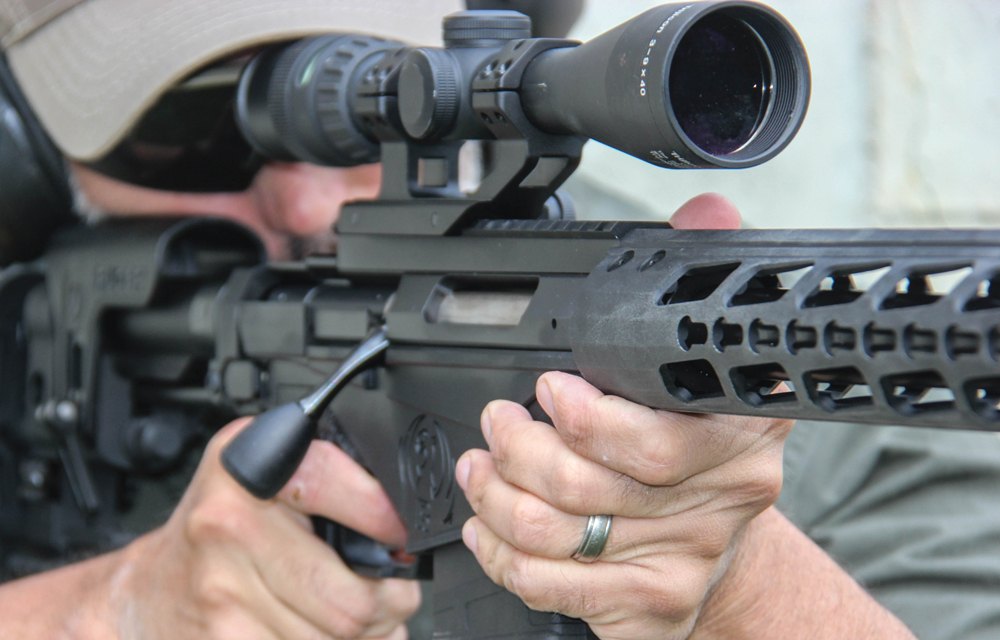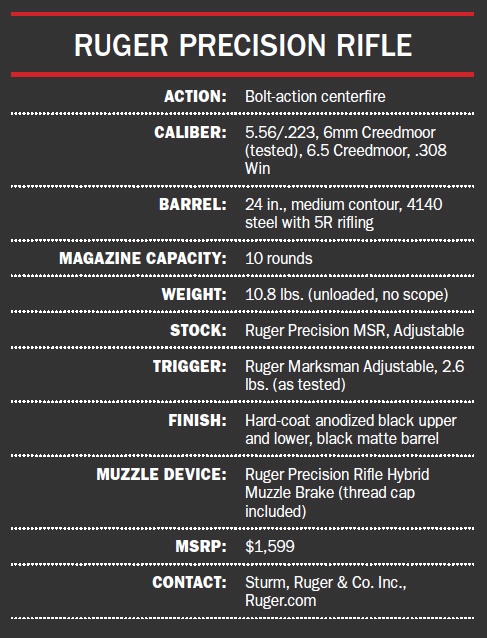
Ruger’s newly updated Precision Rifle has the goods to go the distance.
Some basics on the Ruger Precision Rifle, available in the exciting new 6mm Creedmoor:
- Ruger’s Precision Rifle was purpose-built for long-range shooting.
- It's offered in .308 Winchester, 5.56 NATO/.223 Rem., and 6 and 6.5 Creedmoor.
- The rifle is outfitted with the Precision MSR Stock.
- The stock folds to the left and features adjustable comb height and length of pull.
- At 100 yards, the smallest group went .42 inches with Hornady ELD-X Match ammo.
- The MSRP of Ruger’s Precision Rifle is $1,599.
I was not a great physics student in either high school or college, but I do remember one key fact from those classes (probably because the lesson was taught on the first day): precision and accuracy are different. Accuracy describes measurement to a standard or true value. Precision is a measure of the proximity of values to one another. In shooting terms, tight groups are a result of precise shooting. Accuracy has to do with how close those bullets are landing to your intended target.

Serious long-range accuracy demands both accuracy and precision. When you’re asking a rifle to reach beyond the limits of average sporting firearms — let’s say 400 yards or more — you need a gun up to the task. And while there are many rifles that serve well for close to mid-range shots, once you move targets to a quarter mile or more, the pool of rifles capable of consistently printing tight groups — say MOA or better — starts to thin. Push that to a half-mile and you’re talking about a small class of weapons indeed.
Find Out More About Ruger Firearms
Ruger’s Precision Rifle was purpose-built for long-range shooting, and it has the features to compete in the rarified world of half-mile-plus target guns. For years, precision rifles were primarily produced by custom riflemakers who specialized in this class of weapons, but with the growing popularity of long-range shooting (both recreational and competition), more and more shooters want to push their limits. Ruger decided to build a factory rifle with all of the features and capabilities normally found on more expensive competition guns without the high price tag, and the Precision Rifle does just that.

For starters, Ruger began with an “upper” and a bolt made from pre-hardened 4140 chrome-moly steel. That helps minimize distortion, and CNC machining keeps tolerances tight. The lower magazine well halves are machined from 7075-T6 aluminum and are type III hard-coat anodized for durability. The Precision Rifle’s one-piece bolt has three locking lugs, which allow for a fast and smooth 70-degree bolt lift. It also features a long billet aluminum bolt shroud, and there’s a bolt disassembly tool stored in the shroud for quick disassembly and cleaning as well as a wrench to adjust the Marksman bladed trigger. The Precision Rifle’s upper has a minimized ejection port that improves rigidity, which, in turn, aids in accuracy, and the 20 MOA Picatinny rail is held in place with four #8-40 screws, so there’s plenty of room for mounting large scopes.
The heart of any real long-range rifle is its barrel, and the Ruger’s cold hammer-forged 4140 chrome-moly steel pipe features 5R rifling. Traditional rifling uses four or six lands (smallest bore diameter) and grooves (widest bore diameter) that have 90-degree edges. The lands and grooves are positioned opposite one another, and the lands contact the projectile and force it to spin. 5R rifling, by contrast, uses five lands and grooves with sloping edges on the lands. This accomplishes several things. First, the opposite lands/grooves reduce bullet deformation, and that leads to improved accuracy (er, precision), especially at long ranges.
Second, the sloped land design doesn’t trap fouling like traditional rifling, so it’s easier to keep the bore clean and uniform. The barrel has minimal headspace measurements and a centralized bore. All Ruger Precision Rifles come with medium-contour barrels topped with the company’s Hybrid Muzzle Brake that reduces recoil without the excessive noise and muzzle blast that accompany the use of other brakes. The brake can be removed and replaced with an included thread protector. The barrel’s design, which is completely free floating and attaches directly to the receiver, eliminates bedding, and recoil force moves rearward in a straight line, further enhancing accuracy potential. The Precision Rifle is offered in .308 Winchester and 5.56 NATO/.223 Rem. with a 20-inch barrel and 6 and 6.5 Creedmoor with a 24-inch barrel.
Taking Stock
Ruger outfitted this rifle with the Precision MSR Stock, which folds to the left at the touch of a button, and comb height and length of pull are adjustable by flipping latches on the stock’s right side. One latch releases the comb so it can be raised or lowered; the other moves the stock fore and aft for perfect alignment. Many competition rifles have adjustable stocks, but Ruger’s setup is robust, simple and requires no tools. That’s an important consideration for long-range rifles; time-consuming stock adjustments don’t permit quick changes afield. This system is much simpler. The folding stock hinge is mated with an AR-style buffer, so you can swap stocks if you desire, and there are QD sling attachments and a short accessory rail on the bottom of the stock. The top of the comb is nicely rounded and comfortable, with light texturing for a comfortable cheek weld.

The texturing is about all that’s light on this rifle, though. The rifle that I tested weighed 10.8 pounds and measured 43.25 to 46.75 inches overall, making this a gun that you won’t want to carry when still-hunting whitetails. For a dedicated target rifle, though, the Precision Rifle’s weight and length aren’t a hindrance. The four cartridges this rifle is chambered in are all relatively light kickers, and this in a gun that will weigh over 12 pounds scoped with a loaded magazine. With a built-in brake, the 6mm Creedmoor hardly stirred the rifle when firing. This helps prevent flinching and allows shooters to keep the target within the field of view when firing. The Precision Rifle’s straight-line recoil lifts the muzzle slightly, but there’s very little movement on the bags, so you can deliver follow-ups in a hurry. That’s not usually necessary when target shooting, but it’s one advantage of the Ruger’s design that’s good for Precision Rifle Series shooters who are timed.
The Precision Rifle’s controls and grip design mimic an AR to some degree. There’s a safety selector that is reversible that looks much like what you’ll find on most ARs, but where this gun differs from black guns is that the selector moves just 45 degrees from safe to fire. The pistol grip design is similar to an AR, and the aluminum Short Action handguard has a low-profile design that allows you to mount long-range scopes with large objectives without worrying about clearance issues. Ruger designed this rifle to be compatible with AICS and M110/SR-25/DPMS/Magpul mags as well as some M14 magazines, so there are lots of options available. The gun that I tested came with a 10-round PMAG that fit securely in the magwell, and the release lever rides just behind the magazine. The front of the magwell is also contoured to allow it to act as a brace when firing or to comfortably accommodate your non-shooting hand.
Six Appeal
It was impossible to attend this year’s annual SHOT Show in Las Vegas without appreciating the impact the 6.5 Creedmoor has had on the shooting industry. Originally conceived Hornady as a low-recoiling, highly accurate target round, the 6.5 has permeated every facet of the rifle-shooting world. It is now chambered in ARs, serious long-range tactical bolt guns as well as light mountain rifles for big-game hunting. And it didn’t take long for the 6.5 to produce an attention-grabbing offspring, the 6mm Creedmoor.
Ruger was one of the first companies to start churning out production rifles in 6mm Creedmoor, and the Precision Rifle was the first gun I fired chambered for the necked-down cousin of the 6.5 Creedmoor. Traditionally, 6mm/.243 bullets have run from about 55 to 100 grains, but with longer, heavier bullets with higher ballistic coefficients, the 6mm Creedmoor is a dedicated long-range cartridge also quite capable of taking a variety of game. The ammo I tested — the very first 6mm load to come to market — was Hornady’s 108-grain ELD Match load. There’s little question that Precision Rifle Series competition helped bolster interest in the cartridge. That event requires shooting from 100 to 1,300 yards, so the rifle must be accurate to long range yet must not beat the shooter up too badly (and there are velocity limitations).

The Ruger Precision Rifle is a serious competition and long-range rifle, and the 6mm Creedmoor is a perfect match. The 108-grain ELD Match bullet from Hornady has a ballistic coefficient of .536 — a natural choice for long shots. For comparison to something more familiar, let’s look at Hornady’s 117-grain interlock .25-06 load. That .25-06 bullet has a muzzle velocity of 2,990 feet per second (fps), which is close to the 6mm Creedmoor’s 2,960 fps figure from the same length barrel. At the muzzle, the .25-06 load has about 200 foot-pounds (ft.-lbs.) more energy, but at 500 yards, the 6mm, with its higher BC, is traveling 250 fps faster than the .25-06 load and carrying more than 150 ft.-lbs. more energy. The telling figure, though, is bullet drop. At 500 yards, the .25-06 bullet has dropped 4.5 inches farther than the smaller 6mm bullet. The 6mm Creedmoor is plainly a long-range cartridge, and it’s one that won’t abuse the shooter.
On the Range
The Ruger Precision is a dedicated long-range rifle and has all the features serious competition shooters demand, but how does it perform? At 100 yards — a virtual chip shot for this rig — the smallest group went .42 inch with the Hornady factory ammo, so small in fact that I had to check the backing board to be sure I was indeed looking at a pattern printed from three bullets and not two. But it was legitimate. In fact, the largest three-shot group of the five groups I shot with this ammo went .925 inch, and the average was .65 inch — well below MOA. Average velocity was 2,970 fps, besting Hornady’s promised velocity figure by 10 fps.

All those features Ruger packed into this rifle make it a very user-friendly long-range gun. For starters, as mentioned earlier, it’s easy to adjust the stock’s fit. Second, the Ruger Marksman Adjustable trigger makes producing tight groups easy. It’s adjustable from 2.25 to 5 pounds, and the one I tested came set at 2.6 pounds according to my Wheeler gauge. It’s a bladed trigger, and you quickly learn that once the blade is depressed, you’re within a hair’s breadth of the trigger breaking. Other features also aid in bench shooting, including the contoured magazine well that offers a solid rest for the hand and the oversized bolt handle. There were no feeding, extraction or ejection issues.
With a bit of dialing on the Trijicon scope, I was producing groups that were precise and accurate — tight clusters in the center of the bullseye. Shooting this rifle well is easy, and Ruger has succeeded in doing what they claimed: building a factory rifle with the kind of features that make it a worthy competitor against many custom guns. With an MSRP of $1,599, this isn’t a budget rifle to be sure, but when you consider all of the Ruger Precision Rifle’s capabilities, this gun is actually something of a bargain. So, if you want a rifle that can go the distance and don’t have the money or time to invest in a custom build, this is a legitimate factory alternative. If you do your part, the Ruger will perform, and it performs splendidly.
Editor's Note: This article originally appeared in the June 2017 issue of Gun Digest the Magazine.
Get More Ruger Info:
- Great Ruger Guns
- Ruger No. 1
- Ruger Redhawk
- Ruger Super Redhawk
- Ruger Blackhawk
- Ruger Single Six
- Ruger 10/22
- Ruger LCR
- Ruger LCRx
- Ruger 77/22
- Ruger 77/44
- Ruger SR1911
- Ruger Hawkeye
- Ruger Mark IV
- Ruger SR-556
- Ruger LCP II
- Ruger American Magnum
- Ruger American Rifle
- Ruger Gunsite Scout Rifle
- Ruger SR-762
- Ruger Red Label
- Ruger SR40
- Ruger Single Nine
- Ruger P345

Next Step: Get your FREE Printable Target Pack
Enhance your shooting precision with our 62 MOA Targets, perfect for rifles and handguns. Crafted in collaboration with Storm Tactical for accuracy and versatility.
Subscribe to the Gun Digest email newsletter and get your downloadable target pack sent straight to your inbox. Stay updated with the latest firearms info in the industry.

![Best Concealed Carry Guns In 2025 [Field Tested] Wilson Combat EDC X9S 1](https://gundigest.com/wp-content/uploads/Wilson-Combat-EDC-X9S-1-324x160.jpg)


![Best 9mm Carbine: Affordable PCCs [Tested] Ruger Carbine Shooting](https://gundigest.com/wp-content/uploads/Ruger-Carbine-Shooting-100x70.jpg)
![Best AR-15: Top Options Available Today [Field Tested] Harrington and Richardson PSA XM177E2 feature](https://gundigest.com/wp-content/uploads/Harrington-and-Richardson-PSA-XM177E2-feature-100x70.jpg)

I’ve been drooling heavily since I first saw one and read the reviews. One hasn’t made it to the top of my priority list – yet – but I’m working on it. It’s only a matter of time.